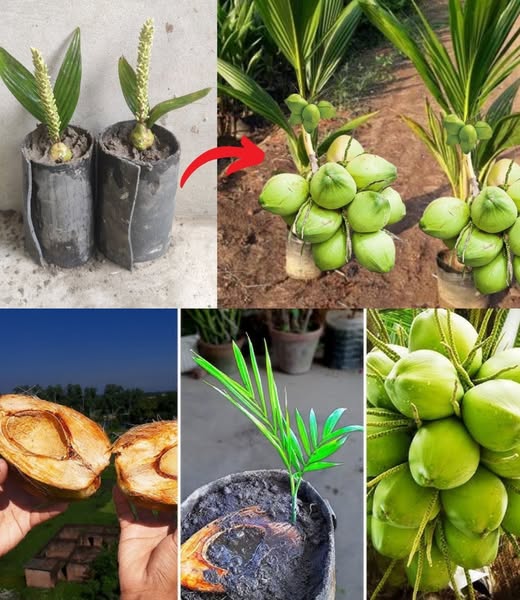Unique Skill: How to Grow a Coconut Tree from a Small Coconut Seed | Easily Grow a Coconut Tree
Growing a coconut tree at home can be a rewarding and fascinating project. While coconuts are typically associated with tropical climates, you can successfully grow a coconut tree from a small seed in the comfort of your own home with a little patience and the right techniques. In this guide, we will share an easy, step-by-step process to help you grow your very own coconut tree from a coconut seed.
Why Grow a Coconut Tree?
A coconut tree is not only a unique and beautiful addition to your home or garden, but it also has practical uses. From producing coconut fruit to providing a decorative touch with its large, green fronds, this tree can be a stunning addition to your collection of indoor or outdoor plants. Moreover, growing a coconut tree from a seed is an educational and fascinating process that connects you to nature and agriculture.
What You’ll Need:
Before starting your coconut tree growing journey, here’s what you will need to get started:
A mature coconut with the husk still intact (this is the seed).
Water (to soak the coconut).
A plastic bag or large container for germination.
A large pot with well-draining soil (if transplanting).
Warm, indirect sunlight for optimal growth conditions.
Step-by-Step Guide to Growing a Coconut Tree from a Seed:
Step 1: Select the Right Coconut Seed
To begin, choose a mature coconut with the husk intact. The coconut should still have water inside (known as coconut water). Avoid using coconuts that are dried out or cracked, as they may not germinate properly. The best coconuts for planting are typically fresh and come from tropical areas.
Step 2: Soak the Coconut Seed
Place your coconut seed in a container of warm water and let it soak for about 2-3 days. This will help soften the hard husk, making it easier for the seed to germinate. You should also make sure the coconut is submerged in the water for proper hydration.
Step 3: Germinate the Coconut Seed
Once your coconut has soaked, it’s time to start the germination process. You can place the coconut seed in a plastic bag or wrap it in a damp cloth and leave it in a warm location. Ideally, the temperature should be between 75°F and 85°F (24°C to 29°C). Indirect sunlight works best to stimulate germination. It may take anywhere from 1 to 3 months for the coconut seed to sprout roots and begin growing a shoot.
Step 4: Monitor for Germination
Check the coconut periodically for signs of germination. You should see a small sprout or shoot emerging from the coconut. At the same time, small roots will begin to form. Once you notice a healthy root system, it’s time to transfer your coconut seed to a larger pot.
Step 5: Transplant to a Pot
Fill a large pot with well-draining soil, such as a mixture of sand and potting soil. Make a hole in the center of the pot, and carefully place the germinated coconut seed inside, ensuring the sprout is pointing upwards. Cover the seed with soil, leaving the top of the coconut exposed. The coconut should be slightly above the soil surface to allow the shoot to grow freely.
Step 6: Provide the Right Conditions
Place the pot in a location with warm temperatures and indirect sunlight. Ensure the coconut is kept moist, but not waterlogged. Water the plant regularly to keep the soil slightly moist, but make sure there is good drainage to prevent the roots from rotting. Over time, the coconut tree will begin to grow taller, and you may start to see the characteristic palm fronds emerging from the top.
Step 7: Maintain and Care for the Coconut Tree
As your coconut tree continues to grow, make sure it receives enough sunlight and stays hydrated. Coconut trees are hardy in tropical environments and thrive in well-draining, sandy soils. If you’re growing your tree indoors, you may need to transfer it to a larger pot or an outdoor garden when it outgrows its current container. You can also prune any dead leaves to encourage healthy growth and to keep the tree looking neat.
Benefits of Growing Coconut Trees:
Natural Shade: Coconut trees are tall and provide shade with their large, fan-shaped leaves, making them ideal for tropical or outdoor gardens.
Coconut Production: Once the tree matures (usually after 6-10 years), it will start to produce coconuts, which are a source of both coconut water and meat.
Decorative Appeal: The coconut tree adds a unique and tropical aesthetic to your home, garden, or patio.
Air Purification: Like other plants, coconut trees help purify the air by absorbing carbon dioxide and releasing oxygen.
Common Mistakes to Avoid:
Not Using Proper Drainage: Coconut trees do not like sitting in water. Make sure the pot has good drainage to prevent root rot.
Exposing the Tree to Direct Sunlight: Too much direct sunlight can harm the seed or young coconut tree. Indirect sunlight is key to successful growth.
Overwatering: While the coconut tree needs moisture, overwatering can lead to root rot. Allow the soil to dry slightly before watering again.
Conclusion
Growing a coconut tree from a small seed is an exciting and relatively simple gardening project that can yield beautiful results. By following these easy steps and ensuring the right growing conditions, you can cultivate your very own coconut tree and enjoy the rewards of this tropical beauty in your home or garden. Whether you’re interested in having your own supply of fresh coconuts or simply love the aesthetic appeal of a coconut tree, this unique gardening skill is sure to delight
